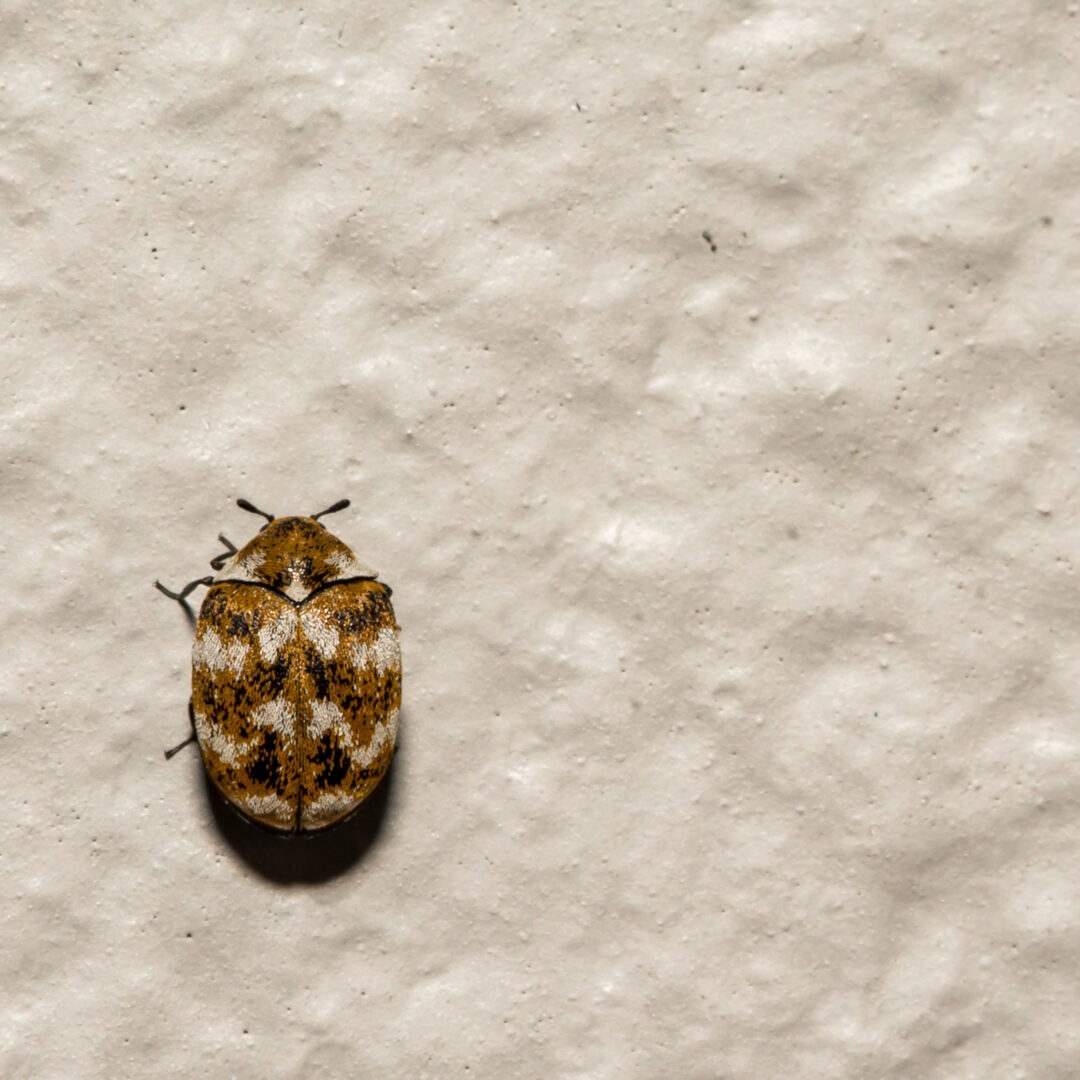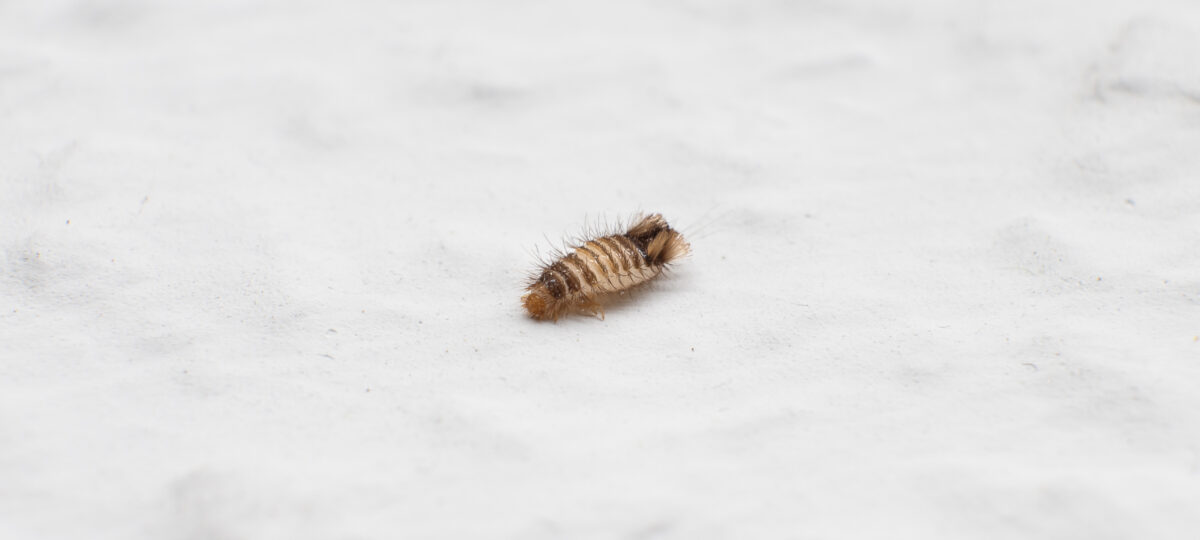What Are Carpet Beetles?

An example of this is carpet beetles. Many people – especially those unfamiliar with insects, worry that carpet beetles are actually bed bugs. They’re not. They’re also harmless to people, but they do cause issues that can affect your property.
Carpet beetles are small, oval-shaped insects that feed on a wide variety of materials found in homes, such as wool, silk, leather, and even some stored food products.
Despite their name, they are not limited to carpets. They can be found in clothing, upholstery, blankets, taxidermy, and other household items, especially those made from animal-based materials.
These beetles can be difficult to spot in the early stages of infestation because they are small, quiet, and slow to cause damage at first. They do *prefer* carpets, but can be found hidden inside of the fibers or underneath, making them harder to spot. Over time, their presence becomes more obvious as they leave behind shed skins, damage to fabrics, and signs of larvae in less-trafficked areas of the home.
What Do Carpet Beetles Look Like?
Carpet beetles exist in both larval and adult stages, each with distinct features. The two look nothing alike so you may worry you have two bugs instead of one, but they’re still the same pest, just at different stages of development.
The larvae are more destructive and resemble small, short, hairy caterpillars. Adults are often confused with other types of small beetles, but they have a dome-shaped body and can appear mottled with a mix of black, white, brown, or yellow depending on the species. Some people describe them almost like a tiny, sepia ladybug.
Common types include:
- Varied Carpet Beetle – Mottled with black, white, and brown or yellow patches.
- Furniture Carpet Beetle – Similar in shape, but with more subtle coloration and found near upholstered items.
- Black Carpet Beetle – More uniformly dark and slightly longer, with smooth, shiny black coloring.
While adults primarily feed on pollen and nectar and are often found near windows, it is the larvae that cause the most concern indoors. Eventually, however, the larva turn into adults, and you’re more likely to see the beetles. Because the beetles do not feed solely on carpets, beetles may forage and become more visible the worse the infestation.
How Do You Get Carpet Beetles?
Carpet beetles are not typically brought in deliberately, but they are extremely common household pests. Like many insects, they are opportunistic. They enter homes looking for food sources, places to lay eggs, and shelter from outdoor conditions.
Most infestations start small and grow slowly over time, often going unnoticed until damage to fabrics or household materials becomes visible. These pests can be introduced into a property in multiple ways, especially when there is limited pest prevention or storage areas that provide access to organic materials.
These include:
- Through Openings in Doors, Windows, or Vents – This is the most likely and most common way that people bring in carpet beetles. Adult carpet beetles are small enough to fit through narrow gaps, especially in aging window frames, vents, and screens. They are attracted to light and may enter in search of food or shelter.
- On Cut Flowers or Outdoor Items – Less commonly, carpet beetles feed on pollen and plant debris in their adult stage, so they may hitch a ride indoors on flowers, leaves, or outdoor furniture.
- Second-Hand Furniture, Rugs, or Clothing – One of the more common ways infestations begin is through used items made from natural materials. Wool rugs, upholstered furniture, and even clothing can carry larvae or eggs without visible signs.
- Via Pet Bedding and Animal Fur – Homes with pets may attract beetles due to the presence of fur, dander, or pet food. Carpet beetles are drawn to organic debris, and pet bedding can provide a food source and egg-laying environment.
- From Bird Nests or Animal Nests Near the Property – Old nests from birds, rodents, or other wildlife can attract beetles. If nests are near vents, chimneys, or rooflines, carpet beetles may migrate indoors from there.
In most cases, people do not notice the initial entry. Infestations usually develop gradually, especially if stored items are rarely moved or cleaned.
Where You Might Find Carpet Beetles
Carpet beetle larva are most likely to be found in darker, harder to disturb areas. For example:
- Under rugs and wall-to-wall carpeting
- Inside air ducts and vents where pet hair and lint collect
- In wool, fur, or feather items
- Stored linens or clothing made of natural fibers
- Inside upholstered furniture
Remember, however, that you are not likely to see these pests. Rather, you’ll see the adult beetles. These bugs are more likely to travel. You may still see them on carpets and furniture, but they’ll be more out in the open. You also may see them near windowsills and light as they’re trying exit.
Because of their ability to feed on a wide range of household materials, carpet beetles can survive in many environments if food sources are available.
Long-Term Risks and Prevention
While carpet beetles are not dangerous to humans in the way that some pests are (they don’t bite or sting), they can cause long-term damage to fabrics and materials throughout the home. The larvae may also trigger allergic reactions in sensitive individuals, particularly if there is regular exposure to shed larval hairs.
Prevention and control typically focus on:
- Reducing clutter and vacuuming frequently, especially in low-traffic areas
- Storing natural fiber clothing and linens in sealed containers
- Using synthetic materials where possible in long-term storage
- Inspecting cut flowers, second-hand goods, and pet bedding before bringing them indoors
- Keeping window screens in good condition and sealing small entry points
If a larger infestation is suspected, professional pest control services may be needed to locate hidden breeding areas and prevent continued damage.
Can Homeowners Get Rid of Carpet Beetles on Their Own?
Carpet beetles are a persistent household pest, but for many homeowners, they can be managed without needing professional pest control. However, successful treatment depends on the extent of the infestation, the accessibility of the affected areas, and the homeowner’s ability to identify and remove all potential food sources.
Early infestations are typically easier to handle with do-it-yourself methods. But as the population grows and spreads into hidden areas, full elimination becomes more difficult without specialized equipment or targeted insecticides.
Steps That Can Help Eliminate Carpet Beetles
If caught early, carpet beetle infestations can often be controlled with a combination of deep cleaning, proper storage, and environmental management.
- Thorough Vacuuming of All Surfaces – Regular vacuuming is unlikely to eliminate carpet beetles, but it can reduce their damage. Make sure that you’re vacuuming areas such as corners, along baseboards, under furniture, and in closets. Both larvae and eggs can be physically removed if vacuumed frequently. However, since some carpeting can be difficult to access (for example, carpet or rugs under beds), it is often not enough to remove the infestation entirely.
- Washing or Dry Cleaning Affected Fabrics – Items made of wool, silk, and other natural fibers should be laundered or dry cleaned at high temperatures. This can kill larvae and remove food sources.
- Sealing Cracks, Gaps, and Entry Points – Caulking around windows, repairing screens, and sealing entry points can limit adult beetles from entering or laying eggs indoors.
- Eliminating Infested Items – Severely damaged or heavily infested items may need to be discarded, especially if they cannot be easily washed or treated. Get rid of any rugs that seem to consistently be attracting them and replace the rugs with those made of non-animal fiber or consider hardwood flooring.
- Reducing Clutter and Organic Debris – Carpet beetles thrive in areas with dust, lint, pet hair, and stored natural fibers. Regular cleaning reduces these hidden food sources.
These can minimize potential damage and prevent larger infestations, but note that a single cleaning session is rarely enough. Most cases require repeated efforts over several weeks, and even then, they are only likely to reduce the infestation not eliminate it provided you already have beetles breeding.

Professional Treatment for Pest Control Companies
Some small infestations of carpet beetles can be managed without professional intervention if action is taken quickly and thoroughly, but remember that most of the time, you don’t know you have an infestation, which means taking action “quickly” is frequently difficult.
On the other hand, larger infestations – or those that have reached hidden spaces – may require help from a licensed pest control technician. Ongoing prevention is often just as important as initial removal, especially for homes with older construction, pets, or long- term storage of natural materials.
What Can Pest Control Companies Do?
When a carpet beetle infestation becomes widespread or resistant to do-it-yourself measures, pest control companies, like ExtermPRO, offer more advanced options for detection, treatment, and long-term prevention. While many homeowners are able to remove small infestations on their own, professional pest control is often more effective for identifying hidden sources of activity, applying targeted treatments, and reducing the chances of reinfestation.
Pest control companies use tools and products that are not typically available to the public, and they are trained to recognize the subtle signs of an infestation even in hard- to-access or concealed areas of the property.
How Pest Control Professionals Treat Carpet Beetles
The role of our team goes beyond spraying insecticide. Our approach is typically comprehensive, focused on identifying the root of the infestation and applying a treatment strategy based on the layout of the home and the level of pest activity.
Common services provided include:
- Thorough Inspection – A detailed assessment of baseboards, closets, attics, insulation, air ducts, furniture, and storage areas to locate the source of the infestation and assess its severity.
- Targeted Insecticide Application – Use of residual insecticides in areas where larvae are likely to hide, including cracks, seams, and beneath carpeting. These products may be stronger than those available to the public and are often applied with precision equipment.
- Use of Insect Growth Regulators (IGRs) – Some companies apply growth regulators that interfere with the development of carpet beetle larvae, preventing them from maturing and reproducing.
- Treatment of Wall Voids and Insulation – In cases where beetles have infested inaccessible areas, pest control professionals may apply dust formulations or foam treatments inside walls and under flooring.
- Sanitation and Prevention Guidance – After treatment, many companies provide recommendations for cleaning, sealing, and storage to reduce future risk. This may include identifying materials that are acting as attractants or sources of food.
- Follow-Up Visits – For larger infestations, multiple treatments may be necessary. Pest control companies often schedule follow-up inspections to ensure that the infestation has been fully resolved.
By using commercial-grade materials and applying treatments based on the pest’s life cycle, professionals are often able to stop infestations that would continue to grow if left untreated.
Get Rid of Carpet Beetles with ExtermPRO
Carpet beetles are rarely noticed right away, but they are persistent. Their ability to live unnoticed in corners of the home – especially those filled with lint, hair, or animal-based materials – means they can cause material damage slowly over time if left untreated. Keeping an eye on vulnerable materials and maintaining a clean, sealed home environment is often the best way to reduce the risk of infestation, but, if you see carpet beetles often or you suspect they’re causing problems, reach out to ExtermPRO, today.